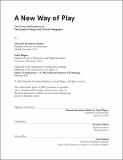A new way of play : the forms and functions of participatory design and critical pedagogies
Author(s)
Beaudouin-Mackay, Alexandre.; Wagner, Sarah,
Download1236882955-MIT.pdf (28.61Mb)
Alternative title
Forms and functions of participatory design and critical pedagogies
Other Contributors
Massachusetts Institute of Technology. Department of Architecture.
Advisor
Brandon Clifford.
Terms of use
Metadata
Show full item recordAbstract
The playful distancing of academic work allows for freedom and innovation, yet architects have not fully explored the expansive opportunities inherent in a more political understanding of play. We conduct this exploration as both means for expanding and growing our own capacity for creativity and as a critique of our own architectural education, which has necessarily been focused on the delivery of defined assets. We are approaching play as a means of developing our own design philosophy. By understanding play as a powerful methodology, architects can engage others in creative processes with the ambition of implementing new, meaningful, and imaginative design strategies. Play is not aimless but productive; it is the way in which we learn to exist in the world. Play changes the way we see our environment, the way we understand ourselves. It creates collaborations and moments of solitude; it is dynamic; it is static. Like the imaginaries we engage, the design of play has always been intrinsically tied to the politics of its era. Today, "play," as we know it, is controlled by an industry obsessed with risk aversion. Play spaces are standardized and generic, not open but relegated to risk-free, fenced off areas. Similarly, our design processes are often isolated, not attentive to the potentials of external communities to open up new possibilities. In the midst of a global call for a new and equitable era, architects can return again to play, not just as a subject but as a method--as a way of working and a form of design research. In a world of increasing tensions and isolationism, architectural work needs to find new ways to be immersed in the world around it. Architects must learn to play with others. This thesis states that for architecture to reimagine play, it must in-turn, learn from play to re-imagine the process and products of design.
Description
Thesis: M. Arch., Massachusetts Institute of Technology, Department of Architecture, February, 2020 Cataloged from student-submitted thesis. Page 172 blank. Includes bibliographical references (pages 169-171).
Date issued
2020Department
Massachusetts Institute of Technology. Department of ArchitecturePublisher
Massachusetts Institute of Technology
Keywords
Architecture.